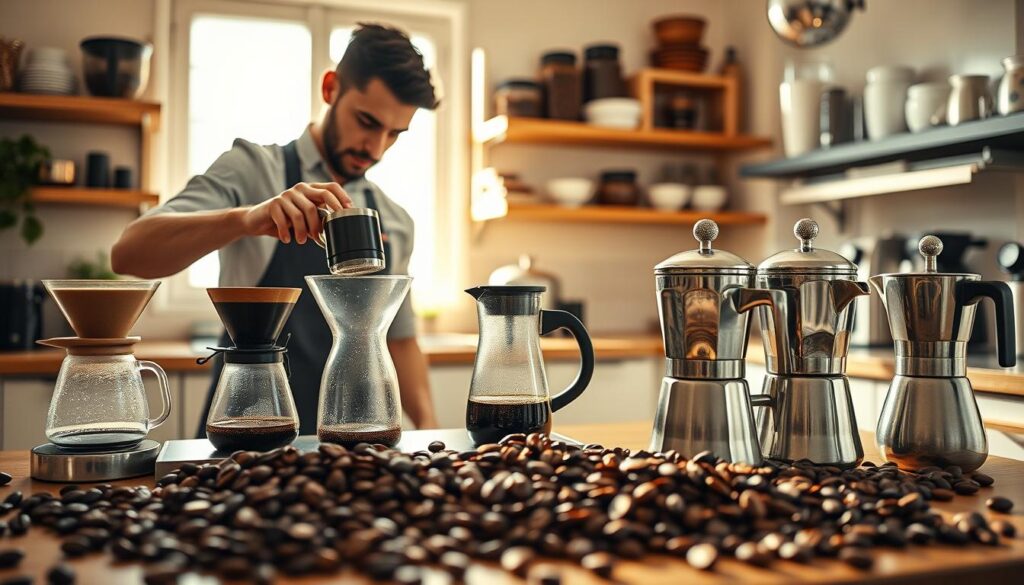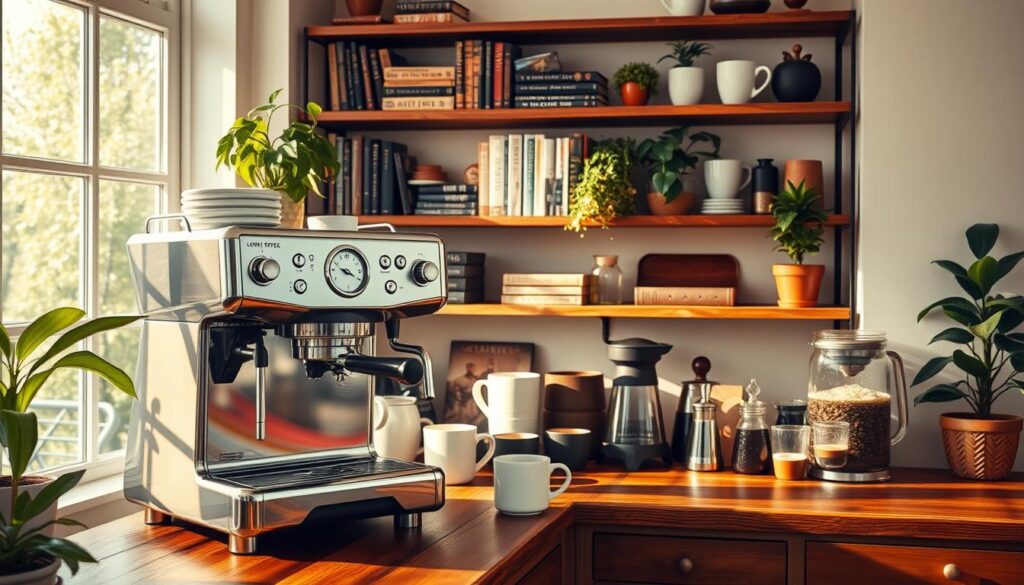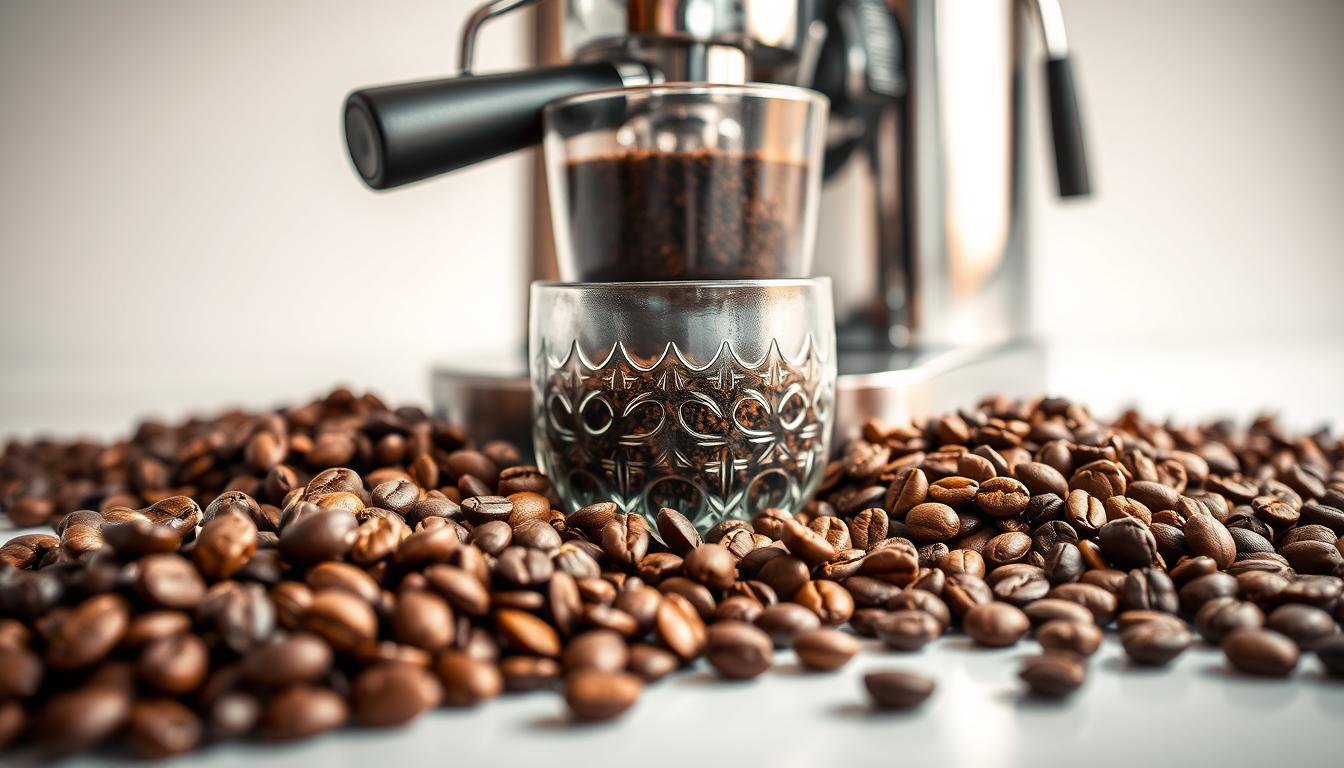What makes a perfect cup of coffee? Is it the rich aroma, the bold flavor, or the way it energizes your morning? For many, a great cup is more than just a drink. It’s a daily ritual that sparks joy and fuels creativity.
As a coffee enthusiast, I’ve learned that crafting the ideal cup involves understanding premium coffee blends and mastering brewing techniques. Whether you’re a seasoned connoisseur or just starting, the pursuit of the perfect cup is both an art and a science.
Key Takeaways
- Understanding the complexities of coffee beans is crucial.
- Mastering brewing techniques elevates the coffee experience.
- Exploring premium coffee blends can enhance flavor.
- The ideal cup is a balance of art and science.
- Coffee is a daily ritual for many, offering more than just a beverage.
My Coffee Awakening: Beyond the Ordinary Cup
My coffee journey started with a search for the perfect artisan coffee experience. I soon learned that making the perfect cup is an art. It involves many steps, each important for the final taste.
From the bean’s origin to how it’s brewed, knowing each step enhances your coffee enjoyment. I found specialty coffee roasters who focus on each bean’s unique qualities.
The Moment I Discovered True Coffee Quality
I remember when I first tasted exceptional coffee. It was from a local specialty coffee roaster. The flavor was complex, with both familiar and new notes. This sparked my curiosity to learn more about exceptional coffee.
What Separates Exceptional Coffee from the Rest
What makes exceptional coffee different? It’s the bean quality, roasting, and brewing. Let’s look at how different roasts affect flavor.
| Roast Level | Flavor Profile | Characteristics |
|---|---|---|
| Light Roast | Fruity, floral | Higher acidity, lighter body |
| Medium Roast | Balanced, nuanced | Medium acidity, balanced body |
| Dark Roast | Rich, bold | Lower acidity, heavier body |
Learning about coffee tasting notes was key. It helped me notice the differences between coffees. By understanding these notes, I could choose the right coffee for me.
Exploring coffee further, I realized it’s more than a recipe. It’s about the art and details that make each cup special. Whether it’s the artisan coffee experience or the brewing technique, every detail counts.
Understanding Coffee Bean Varieties and Their Impact
The perfect cup of coffee starts with knowing the different coffee bean varieties. Over 100 varieties exist, each with its own taste and smell. Choosing the right one can be tough.
I’ve learned to love the differences in coffee beans. There are four main types: Arabica, Robusta, Liberica, and Excelsa. Knowing these differences helps you enjoy your coffee more.
Arabica vs. Robusta: Flavor Profiles and Characteristics
Arabica beans have complex and delicate flavors, like fruit and floral notes. They have a higher acidity and more nuanced taste than Robusta beans. Robusta beans, however, have a strong, bold taste with a harsher flavor.
To learn more about coffee beans, check out this guide. It covers the different types and their characteristics.
How Geography and Terroir Shape Coffee Flavor
The place where coffee beans grow greatly affects their taste. Climate, soil, altitude, and how they’re processed all influence the flavor.
Coffee from high-altitude regions in Ethiopia tastes different, with citrus and fruit notes. Coffee from low-altitude regions in Brazil is milder, with notes of nuts and chocolate.
Single-Origin vs. Blends: Making the Right Choice
Choosing between single-origin and blended coffee depends on your taste. Single-origin coffee shows off the unique taste of a specific region.
Blended coffee mixes beans from various regions for a balanced taste. Here’s a quick comparison:
| Coffee Type | Flavor Profile | Characteristics |
|---|---|---|
| Single-Origin | Distinct, nuanced | Showcases unique regional characteristics |
| Blended | Balanced, smooth | Combines flavors from multiple regions |
By understanding coffee bean varieties, you can choose better and enjoy your coffee more.
The Best Cup of Coffee and Elevate Your Coffee Experience Starts with Bean Selection
Choosing the right coffee beans is the first step to a great cup of coffee. The quality of your coffee beans makes all the difference. High-quality beans are essential for a top-notch coffee experience.
Trying different coffee beans and roast levels can help you find your perfect flavor. As a coffee lover, I’ve learned that finding the perfect cup is all about understanding coffee bean varieties and roast levels.
Premium Coffee Blends That Transformed My Morning Ritual
Premium coffee blends can make your morning coffee time special. I’ve found that blends like Kona blends or Jamaican Blue Mountain add a rich flavor to my coffee.
When looking at premium blends, think about the beans’ origin and roast. A well-balanced blend gives a consistent flavor that’s both satisfying and enjoyable.
Matching Bean Selection to Your Flavor Preferences
Knowing what you like in your coffee is key to picking the right beans. Whether you like a bright and acidic coffee or a smooth and rich one, there’s a bean for you.
To find the right beans, look at the flavor profiles of different varieties. For example, Arabica beans have nuanced flavors, while Robusta beans are bolder.
| Coffee Bean Variety | Flavor Profile | Acidity Level |
|---|---|---|
| Arabica | Nuanced, with notes of fruit and floral hints | Higher |
| Robusta | Bolder, with a harsher taste | Lower |
| Liberica | Fruity and floral, with a hint of spice | Medium |
Decoding Roast Levels: From Light to Dark
Roast levels greatly affect your coffee’s flavor. From light to dark, each level offers a unique taste.
Light roasts have bright acidity and nuanced flavors. Dark roasts are richer and bolder. Knowing which roast level you like is important for enjoying your coffee.
Trying different roast levels can help you find your ideal cup. Whether you prefer the bright taste of a light roast or the deep flavors of a dark roast, there’s a roast level for you.
Specialty Coffee Roasters Worth Discovering
Exploring specialty coffee, I found roasters changing the game. They’re not just roasting; they’re crafting experiences. Their focus on quality and innovation is clear.
Small-Batch Artisans Redefining Coffee Quality
Small-batch roasters are big in the specialty coffee world. They focus on small-batch coffee to try unique flavors. This leads to a more complex taste.
These artisans seek out rare beans and roast them with care. Their love for quality shines in every bag.
Subscription Services That Expanded My Coffee Horizons
Coffee subscriptions let you try many specialty coffees. They match you with coffees you’ll love. It’s a great way to find new favorites.
- Monthly subscriptions bring fresh, small-batch coffee right to you.
- Plans are flexible, so you can try different roasters anytime.
- You get access to special coffees not found in stores.
How Freshness Dates Impact Your Coffee Experience
The freshness of your coffee matters a lot. Specialty roasters show freshness dates on their bags. This helps you choose the best coffee.
For the best taste, pick bags with recent roast dates. Also, keep your coffee in a cool, dark place to keep it fresh.
Essential Equipment for Coffee Excellence
To make great coffee, you need more than just good beans. The right equipment is key to unlocking the best flavors. I’ve learned that the right tools can turn a good cup into a great one.
Grinders: Why Consistency Is Everything
Grinding coffee beans is a crucial step. It affects how well the coffee extracts and tastes. A burr grinder ensures a consistent grind size, which is vital for the best flavor.
The grind size matters a lot. It controls how water moves through the coffee. If the grind is not right, the coffee can taste bad. A burr grinder lets you adjust the grind for any brewing method.
Brewing Devices That Elevate Your Coffee Game
The brewing device is where the magic happens. There are many options, each with its own special qualities. From pour-over to French press, the right device can change the coffee’s flavor.
Pour-over brewing lets you control the brewing process well. It makes a clean, nuanced cup. French press, on the other hand, makes a rich, full-bodied coffee. Knowing what each device does best helps you pick the right one.
Water Quality and Temperature Control Fundamentals
Water quality and temperature control are key but often overlooked. The water makes up most of the coffee. Using fresh, filtered water is crucial to avoid bad tastes or smells.
Temperature is also very important. The ideal brewing temperature is between 195°F and 205°F. Water that’s too hot or too cold can ruin the coffee. Using a thermometer helps me keep the water at the perfect temperature.
Mastering Coffee Brewing Techniques for Different Experiences
Discovering the perfect cup of coffee means learning about different brewing methods. Each method has its own unique flavors and textures. Mastering these techniques can greatly improve your coffee experience.
Exploring coffee, I realized brewing method is key to flavor and texture. Pour-over, French press, espresso, and cold brew each offer a unique coffee experience. Each method requires a different approach, from precision to patience.
Pour-Over Methods: Precision and Clarity
Pour-over brewing is a manual method that lets you control the brewing process. It involves slowly pouring hot water over ground coffee beans in a filter. This method results in a clean and nuanced cup of coffee.
Key benefits of pour-over brewing include:
- Clean and nuanced flavor profile
- High degree of control over brewing parameters
- Flexibility to experiment with different coffee-to-water ratios and brewing times

French Press: Rich, Full-Bodied Immersion Brewing
French press, also known as a cafetière or coffee press, involves steeping coarse coffee grounds in hot water. Then, you press the grounds to the bottom to separate the liquid. This method yields a rich, full-bodied coffee with a heavier body and more oils than pour-over brewing.
The characteristics of French press coffee include:
- Rich and full-bodied flavor
- Higher oil content compared to other brewing methods
- Robust and intense coffee experience
Espresso: The Technical Art Form
Espresso is a concentrated coffee made by forcing pressurized hot water through finely ground coffee beans. It requires precision in grind size, tamping, and brewing time to achieve the perfect shot.
Key factors in making great espresso include:
- Fine grind size for optimal extraction
- Proper tamping to ensure even extraction
- Precise brewing time and temperature control
Cold Brew: Patience and Smoothness Rewarded
Cold brew coffee is made by steeping coarse-ground coffee beans in cold water for 12 to 24 hours. This method produces a smooth, low-acidity coffee that is perfect for hot summer days.
The benefits of cold brew coffee are:
- Smooth and low-acidity flavor profile
- Less bitterness compared to hot-brewed coffee
- Versatile for various coffee drinks and recipes
The Science of Perfect Extraction
Getting the perfect cup of coffee starts with understanding extraction science. It’s all about getting the right amount of coffee compounds into the water. This makes your coffee balanced and flavorful.
Golden Ratios: Coffee-to-Water Measurements
The coffee-to-water ratio is key for perfect extraction. Too little coffee makes the brew weak, too much makes it too strong. The ideal ratio changes with brewing methods, but start with 1:15 to 1:17 (coffee to water).
For every gram of coffee, use 15 to 17 grams of water. Adjusting this ratio helps you fine-tune the flavor to your taste.
For more on coffee extraction science, check out The Calculated Chemist. They dive deep into the chemistry of coffee extraction.
Grind Size Science for Different Methods
The grind size of your coffee beans affects extraction speed. A finer grind means faster extraction, while a coarser grind slows it down. Espresso needs a fine grind, pour-over a medium, and French press a coarse.
Getting the right grind size for your brewing method is crucial for perfect extraction.
Timing Your Brew for Flavor Optimization
Brewing time is also crucial. Longer brewing times extract more coffee, but too much can make it bitter. Espresso brews for 20-30 seconds, while cold brew steeps for hours.
Knowing the best brewing time for your method and adjusting it is key to perfect flavor.
Mastering coffee-to-water ratio, grind size, and brewing time enhances your coffee’s flavor. Experimenting with these variables lets you customize your coffee to your liking, ensuring a perfect cup every time.
Developing a Coffee Connoisseur’s Palate
Becoming a coffee connoisseur is more than just liking good coffee. It’s about understanding its complex flavors and aromas. Learning to identify and appreciate these nuances makes each coffee unique.
Coffee Tasting Notes: Learning the Language
First, learn the language of coffee tasting notes. This means understanding the flavors and aromas in a cup of coffee. You might find notes like fruity, floral, chocolatey, and nutty. Familiarize yourself with the coffee flavor wheel to better understand these.
When tasting coffee, you might notice citrus or berry flavors. These come from the coffee beans’ origin and how they’re processed. Recognizing these notes helps you appreciate the coffee’s complexity.
The Coffee Flavor Wheel as Your Guide
The coffee flavor wheel is a key tool for improving your palate. It gives you a standard way to describe coffee flavors and aromas. Using it helps you communicate your coffee preferences and explore different profiles.
The flavor wheel can show you the difference between light and dark roasts. It helps you see the craftsmanship in roasting coffee.
Conducting Professional-Style Cuppings at Home
Cuppings, or coffee tastings, are a great way to evaluate different coffees. By doing cuppings at home, you can compare various beans, roast levels, and brewing methods. This involves preparing each coffee carefully and tasting them.
To cup at home, you’ll need a grinder, a brewing device, and cups. Here’s a simple table to help you get started:
| Equipment | Purpose |
|---|---|
| Grinder | To freshly grind your coffee beans |
| Brewing Device | To brew coffee according to your preferred method |
| Cups | For tasting and comparing different coffees |
By following these steps and using the right tools, you can develop a sophisticated palate. This will make your coffee experience more rewarding.
Creating an Artisan Coffee Experience in Your Space
Turning your coffee time into an artisan experience is more than just making a cup. It’s about making a ritual that makes you appreciate coffee more. By setting up a special space for coffee, you can enjoy an artisan coffee experience at home.

Designing Your Ideal Home Coffee Bar
Starting with a home coffee bar is key to an artisan coffee experience. This area needs the right tools, like a grinder, brewer, and scale, for top-notch coffee.
Think about how your coffee bar looks too. It should be welcoming and make you want to linger. Add coffee-themed decor or a unique light to make it your own.
| Essential Equipment | Recommended Brands | Key Features |
|---|---|---|
| Coffee Grinder | Baratza, Breville | Consistent grind size, adjustable settings |
| Coffee Brewer | Bonavita, Chemex | Precise temperature control, even extraction |
| Coffee Scale | Acaia, Hario | Accurate measurements, timer functionality |
Morning Rituals That Enhance Appreciation
Creating a morning ritual can make you appreciate coffee more. Take a few minutes each morning to enjoy your coffee fully.
Adding activities like meditation, journaling, or reading can make your morning even better. It sets a positive start to your day.
Food Pairings That Complement Coffee Profiles
Trying different foods with your coffee can make your experience even better. Pair your coffee with treats like pastries, nuts, or cheese for a great flavor mix.
For example, a bright coffee goes well with sweet treats like croissants. A bold coffee pairs well with savory snacks like nuts or cheese.
Top Coffee Shops Across America That Inspired My Journey
From the West Coast to the East Coast, America’s top coffee shops have changed my coffee journey. Visiting these specialty coffee places was a big part of my coffee exploration.
West Coast Innovators Setting New Standards
The West Coast is famous for its creative coffee culture. Shops like Blue Bottle Coffee in California have raised the bar with quality and sustainability. Their pour-over methods and expert coffee drinks have made the coffee experience better.
Intelligentsia Coffee, also in California, is known for its top-notch, direct-trade coffee beans. Their cafes offer a refined coffee experience, focusing on each coffee’s unique flavors.
Midwest Hidden Gems Worth the Trip
The Midwest might not be the first thought for coffee innovation, but it has its own treasures. Four Barrel Coffee in Chicago is a standout, with unique and tasty coffee blends. Their dedication to quality and service makes it a must-see.
The Crown Coffee Lab in Kansas City is another gem, famous for its experimental brewing and cozy vibe. It’s a spot for coffee lovers to try new flavors and techniques.
East Coast Establishments Blending Tradition and Innovation
The East Coast is home to some of the oldest and most respected coffee places. George Howell Coffee in Massachusetts is a great example, blending traditional roasting with quality. They offer classic and innovative blends.
In New York, Devocion is known for its direct-trade beans and unique brewing. Their cafes offer an immersive coffee experience, from start to finish.
Sustainable and Ethical Coffee Choices
As a coffee lover, I’ve learned how vital it is to choose sustainable and ethical coffee. The coffee world affects the environment and the people who grow it. By picking our coffee wisely, we help make the industry better for everyone and the planet.
Certifications That Matter
It’s key to know about Fair Trade and Organic certifications. Fair Trade means farmers get fair prices and good working conditions. Organic farming means no harmful chemicals are used.
- Fair Trade: Promotes fair prices and better trading conditions for farmers.
- Organic: Encourages sustainable farming practices without synthetic fertilizers and pesticides.
- Rainforest Alliance: Focuses on conservation and sustainability, ensuring a healthy ecosystem.
The Impact of Direct Trade Relationships
Direct trade between roasters and farmers greatly improves coffee quality. It means better beans and higher prices for farmers. For example, Starbucks has started direct sourcing, as shown in their sourcing practices. This boosts quality and supports green farming.
Reducing Environmental Impact
It’s crucial to lessen coffee’s environmental harm. Shade-grown coffee preserves nature, and eco-friendly packaging cuts waste. By choosing brands that care about the planet, we help too.
- Choose shade-grown coffee to support biodiversity.
- Opt for eco-friendly packaging to reduce waste.
- Support coffee brands that prioritize sustainability and ethical sourcing.
Conclusion: Your Path to Coffee Excellence
Reflecting on my coffee journey, I see it as ongoing. Learning, trying new things, and staying updated are key. Expert coffee reviews and tips from connoisseurs have helped me grow.
Understanding coffee’s details, like choosing beans and brewing methods, has improved my coffee. Sharing what I know and choosing sustainable coffee helps our community grow. We all value great coffee.
Keep exploring and trying new things on your coffee journey. Whether it’s new blends or brewing methods, each step makes your coffee better. Enjoy the journey!
FAQ
What is the difference between Arabica and Robusta coffee beans?
Arabica and Robusta are two types of coffee beans. Arabica has a complex flavor, while Robusta is harsher and more bitter.
How do I choose the best coffee beans for my taste preferences?
Think about flavor, roast level, and where the beans come from. Try different blends and single-origin beans to find what you like. Use the coffee flavor wheel to help pick the right beans.
What is the ideal coffee-to-water ratio for brewing coffee?
The best ratio depends on how you brew your coffee. Aim for 1:15 to 1:17 coffee-to-water. Adjusting this ratio can change your coffee’s taste. Learning about extraction is key to a great cup.
How can I enhance my coffee experience at home?
Create a special space for brewing coffee. Add morning rituals and try foods that go well with your coffee. Use good equipment like grinders and brewers to improve your coffee.
What are some sustainable and ethical coffee choices available?
Look for Fair Trade and Organic certifications. Choose beans from direct trade and specialty roasters. These choices support quality and sustainability in the coffee world.
How do I develop a sophisticated palate for coffee?
Learn to recognize coffee flavors and use the flavor wheel. Practice cupping at home. This will help you appreciate coffee more and become a connoisseur.
What are some expert coffee reviews and coffee connoisseur tips?
Experts stress the importance of fresh beans and proper storage. Try different brewing methods to find your favorite flavors and textures.








